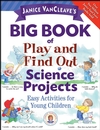Have you ever used art to teach chemistry?
In fact once I used special cotton balls that changed color with changes in the humidity (amount of moisture in the air.) The cotton was blue when the air was dry and pink when there was more moisture in the air.
My students thought they were doing something silly by designing pictures and gluing on blue cotton balls. The cotton was used for clouds, bunny tails, clown noses etc.. Even 6th graders found this project a bit elementary and high school students thought my brain had been affected from mixing too many chemicals. I must admit that the pictures looked a little out of place taped to the wall of a high school chemistry class.
Note that the the 6th grade and high school classes did the same activity–using blue cotton balls to make pictures. I told the classes that we’d discuss the pictures later, and then I continued with other activities.
It took a few days, but when the humidity changed so did the color of the clouds, bunny tails and clown noses. At first the color change was subtle, occurring around the edges where the cotton fibers were thin. I never said a word about it. When the color change was more obvious one of the students noticed it and it was a domino effect. Everyone started looking at the pictures. So now they wanted to know what was up with the cotton. At first they thought I had sprayed the cotton with something to make it change colors. NOPE!!! Guess again. Wow! Were they actually giving hypothesis on their own? YEP!
When they gave up–or actually guessed that the cotton had something to do with changes in the weather—it was time to explain just why the cotton changed.
The information for the 6th grade was different than that for the high school chemistry class. For the younger class, they were introduced to the idea that some chemicals can change color depending on the humidity of the air. When the air was dry the cotton was blue. When the air was wet, the cotton was pink. Yes, we left the pictures and observed them over a period of time. The cotton changed from blue to pink and back to blue again and again.
For the Chemistry Class:
- Hydrates are chemicals that have water as part of their structure. If these chemical lose some or all of this water they change in appearance.
- Cobalt Chloride is the hydrate used on the cotton balls. When the chemical is hydrated (having water) its color is pink. When this chemical dehydrates (loses water) its color is blue.
Big Book of Play and Find Out Science Projects
Using this book as a guide, you and your favorite budding scientist can have fun exploring the world while you help your child learn about science and develop important science process skills. You may think it’s hard to get young children interested in science, but just watch their eyes light up when they make bouncy blubber or play clay, or when you venture out together in the backyard or local park for a bug-collecting expedition. These are the kind of everyday explorations that give kids a great foundation for a lifetime of science learning.
